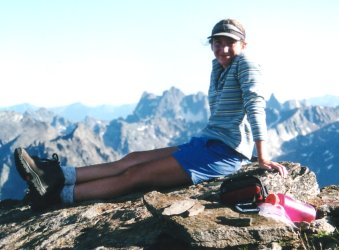

Jennifer Aschoff, PhD Aspirant

Contact Information:
Department of Geological Sciences, UT-Austin
Office: 6.120; No phone
E-mail: jaschoff@mail.utexas.edu
Former Websites: http://serc.carleton.edu/msu/jena.html
Current Research Summary:
My academic research is concerned with how synorogenic sediments record the dynamic development and collapse of ancient orogens. This question forms the basis for all of my current and past research, and continues to fuel my intrigue and dedication to geologic research.
Two chief components comprise my PhD research including:
(1) Analysis of Tectonic Signatures Throughout a Foreland Basin Succession
“Tectonic signatures” (sensu Frostick and Steel, 1993), or indicators, have been used in numerous studies to deduce the role of tectonics, paleogeography and precise kinematic development of structures. Such signatures refer to characteristics within synorogenic sedimentary successions that suggest deposition synchronous with tectonism, and supply the best record of uplift and subsidence.
This phase of the project will likely include a review of all stratigraphic indicators of tectonics and careful analysis of a few key signatures. Growth strata may be used to interpret detailed structural histories; however, the extent to which these can be used to interpret regional tectonics, and how they relate to stages of basin evolution are concepts that are not well understood.
To determine how “proximal” indicators of tectonics grade into more “distal”, or “cryptic” (sensu Miall et al. 2001) indicators, I am examining lateral trends in syntectonic unconformity development. Specifically, I am interested in how incision, paragenesis and facies stacking patterns vary laterally along syntectonic unconformities and their basinward-equivalents. This phase of the study uses recently-discovered, Upper Cretaceous growth strata exposed in SE Nevada to document such trends.
See my recent abstracts to get a feel for some preliminary results.
(2) Genetic Connection Between Anomalously-extending Sandstone Tongues and Thrust-belt Transverse Zone Conglomerate Complexes in the Cordilleran Foreland Basin
Current foreland basin models do not adequately explain basin evolution in the context of complete “foreland basin systems” (sensu DeCelles and Giles, 1996), and do not integrate proximal (<100 km) and distal depositional zones (>100 km) in any detailed way. However, hinterland-derived sediment, and the record of tectonics it supplies, is stored not just in heavily-studied proximal zones, but throughout the basin. Hence, detailed consideration of sediment deposited within all depozones of foreland basin systems supplies more information than traditional approaches.
Enigmatic marine sandstone tongues (traversing >700km) locally occupy distal (eastern) zones of the North American Cordilleran foreland basin. The process by which these tongues crossed astonishingly long distances and how they relate to stages of basin development are unresolved problems in sedimentary geology. The Upper Cretaceous (Campanian) Cozzette Member and eastern equivalents comprise one such tongue, stretching from Utah to Central Colorado. The Cozzette Member. broadly correlates spatially and temporally with syntectonic, transverse-zone conglomerate complexes (sensu Lawton et al., 1994). This conglomerate complex is partly represented by quartzite conglomerates of the Price River Fm within the Cordilleran thrust belt. Given appropriate sea-level conditions, conglomerate complexes may have provided critical sediment point sources and the driving force required to feed rapidly-prograding deltas and basinward-extending sandstones. Establishing the precise connectivity of proximal and distal deposits within a chronostratigraphic and sequence-stratigraphic framework will elucidate the genesis of basinward-extending sandstone tongues. Furthermore, establishing such a detailed up- to down-dip connection provides a more detailed view of foreland basin development and the record of tectonics in the context of a complete foreland basin system (sensu DeCelles and Giles, 1999).
This phase of the project will exploit the incredible exposures, subsurface and stratigraphic/biostratigraphic database available for Campanian strata exposed in Central Utah. I will extend existing stratigraphic correlations (Hettinger and Kirschbaum, 2002; Horton et al., 2004) further up-dip into the Wasatch Plateau area and further down-dip into Central Colorado.
Past Research: (Coming Soon)
Field Photos: (Coming Soon)
Preliminary Research Results: (Coming Soon)
***All photos and content COPYRIGHT by J. Aschoff; please e-mail for permission to use***